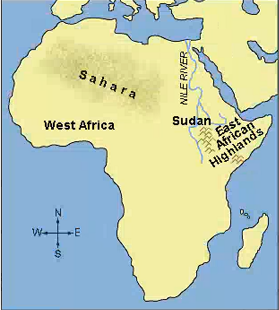

 At the end of the Pleistocene (around 10,000 B.C.), the technologies of food production may have already been employed on the fringes of the rain forests of western and central Africa, where the common use of such root plants as the African yam led people to recognize the advantages of growing their own food. The yam can easily be resprouted if the top is replanted. This primitive form of "vegeculture" (cultivation of root and tree crops) may have been the economic tradition onto which the cultivation of summer rainfall cereal crops was grafted as it came into use south of the grassland areas on the Sahara's southern borders.
At the end of the Pleistocene (around 10,000 B.C.), the technologies of food production may have already been employed on the fringes of the rain forests of western and central Africa, where the common use of such root plants as the African yam led people to recognize the advantages of growing their own food. The yam can easily be resprouted if the top is replanted. This primitive form of "vegeculture" (cultivation of root and tree crops) may have been the economic tradition onto which the cultivation of summer rainfall cereal crops was grafted as it came into use south of the grassland areas on the Sahara's southern borders.A.Food production started with the cultivation of root plants and developed to include the cultivation of cereal crops.
B.In order to avoid human and animal sleeping sickness, which posed a danger to herders and cattle, more and more herders took up cultivation.
C.By 1500 B.C. cereal agriculture was widespread throughout the savanna belt south of the Sahara, and shifting agriculture was used effectively and widely by farmers.
D.Pastoralists who moved south across the Sahara to find suitable land for cattle grazing may have also cultivated some crops for food.
E.Hunter-gatherer groups in eastern and southern Africa raided their herding neighbors to acquire cattle and other domesticated animals.
F.Slash-and-burn agriculture was initially rejected by farmers because it was too labor-intensive, but once the technique was improved, it expanded gradually to eastern and southern Africa.